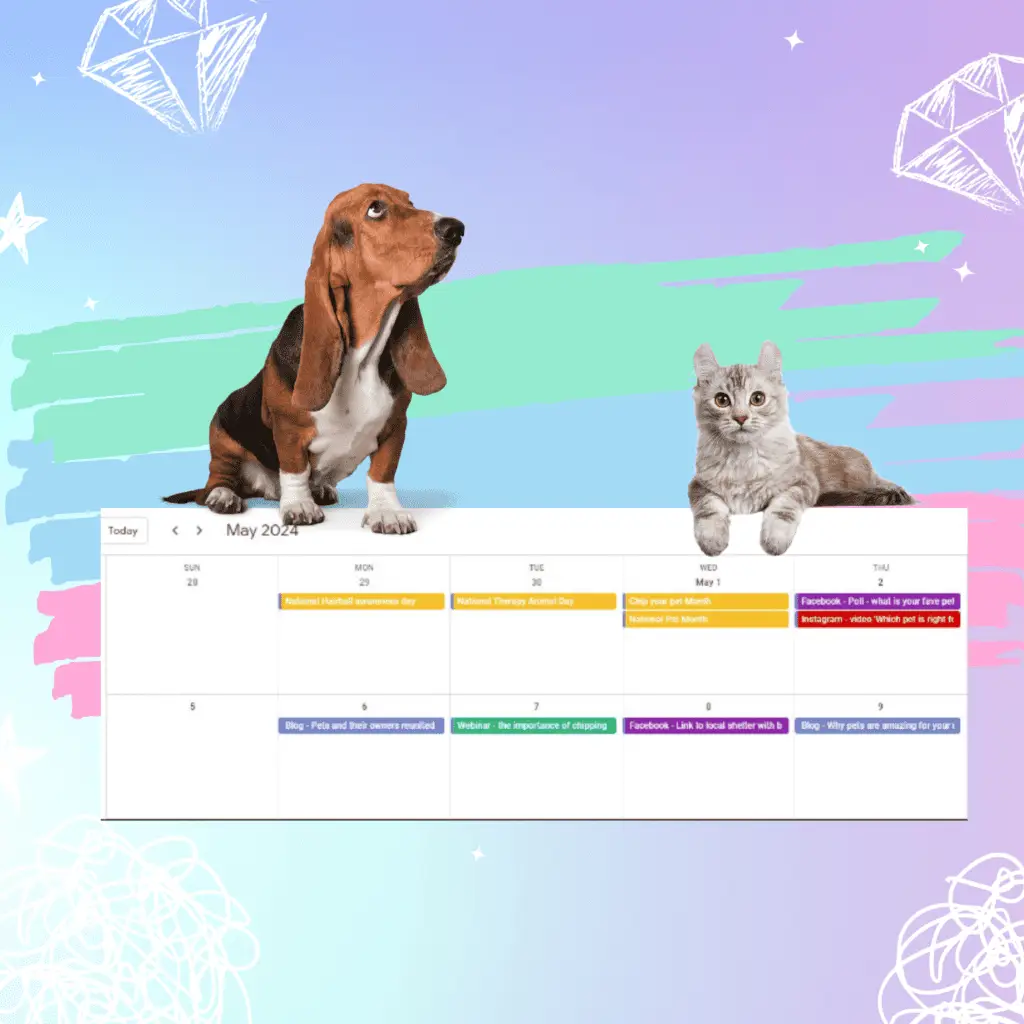If a content calendar were a Friend’s character it would be Monica – a super detail-oriented planning machine!
(For those of you who are Friend’s fans, think of the episode where Chandler asks Monica to help him get into shape. I am talking about this level of meticulous planning only slightly less annoying)
What is a content calendar?
In simple terms, this is a plan for your blogs, articles, images, videos, stories, adverts, social media, and emails!
According to Webinar Care, top marketers were 414% more likely to report success when they document their strategy yet 40% still don’t do it.
Think of the content calendar as the ‘What’, ‘When’, ‘Where’, and ‘Who’ of the digital marketing world.
👉What should you share?
👉When should you share it?
👉Where should you share it?
👉Who is responsible for creating it?
Why is a content calendar so awesome?
A scattergun approach to uploading your content is as short-sighted as your Granny Mavis.

Benefits of a content calendar and consistently posting
There are a lot of benefits to the kind of forward planning a content calendar offers:
Consistency
Posting regularly helps you connect with your audience. Readers will start to recognise your brand and this promotes engagement and builds trust.
Algorithm
Social media platforms reward consistent engagement and posting. You are more likely to show up in news feeds with regular content. This means there is more chance your posts will be shown to more people.
Variety
You will avoid the error of repeating the same content. Your content will be better thought out, higher quality, more relevant, and more engaging.
Events
Never miss an opportunity to tie your content to an important national holiday, observance, campaign, important date within your company, trend, or any relevant dates within your industry. For example, you could plan some of your month’s content around Chip Your Pet Month or Rainbow Bridge Remembrance Day.
Organisation
If you have a larger team then it will be clear who is responsible for each task and deadline. You could use Google Calendar which is free and can be shared live with everyone. (Tip – Colour code tasks as red, amber, and green to indicate whether they have been started or are ready to be published)
Stress
Content Calendars are as helpful to your cortisol levels as yoga and a kale smoothy. This one is fairly self-explanatory (unless you are Monica).
Save time
By planning all your content ahead of time you maximise time for creativity, research, and scheduling. You can focus only on creating high-quality interesting posts instead of running from one idea to the next trying to fill gaps like a headless chicken.
Deadlines
You are in control and will never be at the mercy of a last-minute content deadline. Typically you would create your content calendar 3-6 months ahead of time.
Engagement
By analysing the results of your previous content, you can assess when your audience is most active and most likely to engage with your content and schedule accordingly.
Automation
Once you have created the content you can schedule it! No more thinking daily about what you might post. This frees you up to focus on running the rest of your business.
Brucie bonus

Let me share two sneaky search engine optimisation (SEO) benefits to planning your content in this way! (This means Google will be happy for a hot minute and your customers are more likely to stumble across your business)
1) Cornerstone content
Cornerstone content is where you create 5-6 main articles and blogs that address the core topics and keywords within your industry.
When you create cornerstone content this helps Google understand what your business is about and which queries your content can help customers with.
An example of a main cornerstone content blog for a pet food company that specialises in nutrition for senior pets would be:
‘Caring for a senior pet. Special considerations for aging pets’ health and comfort’
These blogs need to be approximately 1400 words long and would need to be a very comprehensive article that touches on a lot of other topics but not in great detail. Ultimate guides make very good cornerstone pieces.
Then plan the rest of your shorter content around this main topic with blogs between 800 and 1000 words.
Examples:
- Senior pet nutrition
- Mobility and exercise for aging pets
- Health monitoring and vert visits
- Managing chronic conditions
- Pain management
- Emotional well–being of senior pets
You can then link all of your relevant content to the cornerstone content and this allows Google to crawl across all the different pages on your website hence giving it a better idea of what your business does, sells, or specialises in.
Imagine trying to do this without a content calendar.
2) Keyword planning
Keywords are the words and phrases your customers use to find what they are looking for online. You can use these in your calendar to create the blogs in your content plan.
With a consistent approach, in time, search engines will start to recognise your website as a reliable source answering queries around these keywords and questions. This makes it far more likely that you will appear as a suggestion when your customers are asking about these topics on Google.
How do I get started on making a content calendar?
When creating your content calendar keep it simple and remember its purpose.
You need to include:
👉What each piece of content will be about
👉When the content will be published
👉Where the content will be published
👉Who will write the content
👉Deadline for the submitted draft (if outsourcing)
Does this sound long, boring, and tedious?
As a Content Writer in the pet industry, I can develop a content calendar for your blog content.
I will also write all of the blogs for you for the entire year; you can then use this to plan your social media posts and emails.
Just complete my contact form and we will go though this process:






1 thought on “Why your business needs a blog content calendar”
Pingback: Should I hire a freelance content writer to write my blog?